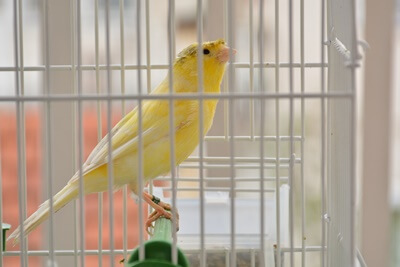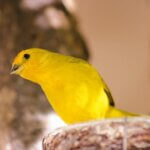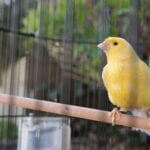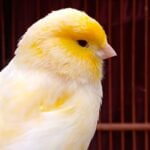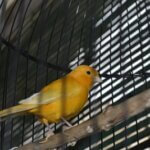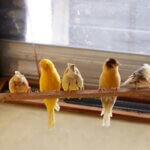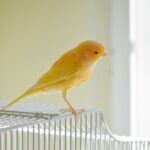When a canary sneezes, it’s a way for the body to clear the airways and remove any accumulated dust or debris. These will be ‘dry sneezes’ and only happen occasionally.
Canaries breathe in and out via two openings on either side of their beaks, known as nares. The diameters are small, but they have to remain open at all times.
For this reason, canaries are susceptible to pollen grains and dust particles clogging these openings. When this happens, the canary instinctively sneezes to force the foreign objects out.
However, when a canary has an infection, or the air conditions aren’t favorable, the sneezing may accompany nasal discharge. This could be thick or watery and will go on long-term.
Thin, clear nasal discharge may resolve if the canary’s immune system is bolstered. However, a thick discharge signifies a severe infection of the canary’s respiratory tract.
Is It Normal for Canaries to Sneeze?
Canaries may sneeze 2-3 times a day on average whenever they encounter a nasal irritant, like dust. Even without irritants in the nostrils, it’s normal for canaries to sneeze occasionally.
However, regular sneezing is neither normal nor healthy, meaning more than four times a day. If you suspect your canary is sneezing too much, take it to a vet for a check-up.
According to Experimental and Applied Acarology, a veterinary examination usually involves choanal and sinus swabs to check for fungal, bacterial, and chlamydia infections.
If the first batch of tests doesn’t provide conclusive answers, your vet may perform additional tests. These will likely include the following:
- Nasal biopsies
- Mycoplasma swabs
- Radiographs
- Blood biochemistry hematology
Why Does My Canary Sneeze So Much?
Excessive sneezing in canaries may result from diseases or debris. How you deal with sneezing will, of course, depend on the cause. So, it’s helpful to conduct a preliminary diagnosis:
Non-Disease (External) Causes
There will be no discharge, and the nares won’t show any signs of irritation or illness apart from sneezing. Here are the most common environmental reasons for sneezing in canaries:
Smoke
Smoke contains heated chemicals that can irritate a bird’s nasal cavity when inhaled.
So, you can expect your canary to sneeze if you keep it in a smoky room, whether that’s smoke from the kitchen or an area where cigarettes have been lit.
Feather Dust
Under normal circumstances, canaries don’t produce much feather dust.
However, this can change due to overgrooming or a difficult molt. Also known as dander, this dust is potent enough to trigger allergic responses in your canary.
Molting in canaries almost always takes place between summer and fall.
If your canary sneezes a lot during this period and doesn’t manifest other signs of illness, you give it time to see if the sneezing will stop once all feathers are replaced.
You can also tamp down on the feather dust by gently misting your canary with a spray bottle and cleaning the cage more regularly.
Dust and Debris
If you live in an area where dust storms are common, some particles will likely reach your canary’s nares and cause it to sneeze. This is true if you always sweep and dust your house while the bird is near.
Luckily, debris can be sneezed out and usually won’t cause long-term infections. Just be sure to move your canary to a different room or cover its cage while performing a deep clean.
A certain amount of dust is a part of life for all animals, but heavy exposure could make breathing difficult or uncomfortable for your bird.
Low Humidity
Canaries are genetically adapted to living in warm, humid environments. As a result, they’re prone to sneezing during the winter when your home’s heaters inadvertently suck moisture out of the air.
Extremely dry air makes breathing difficult, and your canary’s nostrils will be forced to produce extra mucus to compensate for the lack of moisture.
Some of that mucus will find its way down the nares, while the constant inflow of dry air will irritate the canary’s nostrils. Both factors can trigger sneezing and wheezing.
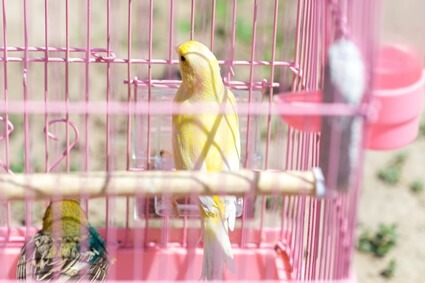
Health-Related Causes
Notably, sneezing may be caused by more alarming factors, like mild or severe health issues. The majority of nasal and respiratory conditions have similar symptoms, so keep an eye out for the signs:
Nasal Infections
If you detect thick nasal discharge in your sneezing canary, this warrants your immediate attention. It’s often the first and most important sign that your canary has an infection or disease.
Of course, nasal discharge, by itself, isn’t enough to diagnose an infection. A thin discharge could arise from a momentary irritation of the bird’s nostrils. However, routinely wet sneezes with heavier discharge are concerning. They’re usually paired with symptoms like:
- Lethargy
- Watery eyes
- Fluffed feathers
- Sleepiness
- It sounds that are similar to coughing
- Changes in voice
- Wheezing
- Reduction in singing frequency
- Failure to perch
Vitamin A Deficiency
Vitamin A is the primary mineral in developing and maintaining soft tissues in your canary’s body. It may become deficient if you don’t regularly feed your bird leafy greens or red/orange vegetables.
Once it does, the nasal area and the respiratory tract will deteriorate. The nostrils will get dry, and there will be an overproduction of mucus. This is often accompanied by sneezing.
Bacterial, Viral, and Fungal Infections
Bacterial and fungal infections are common in all bird species. They often derive from a lack of fresh air, contaminated water, and contact with humans and other pets.
Since both pathogens thrive in moisture, most infections will be concentrated on the nares and eyes. So, infected canaries will most likely have nasal discharge and watery eyes.
Since bacteria can be stubborn, infections often go beyond the respiratory tract. You may spot diarrhea and watery stool. Fortunately, both pathogens are easily treatable.
Viral infections are more difficult to spot and treat since they primarily weaken a bird’s immune system. As a result, symptoms like sneezing and coughing happen while the canary’s body deteriorates.
Trauma
Canaries aren’t overly social and may fight if they feel their territory is threatened. If a canary’s beak gets hurt in a fight, it may constantly sneeze and sniffle due to the pain and discomfort.
Air Sac Mites
Canaries are prone to air sac mite infections, with the risks being overly high for birds that live in unhygienic conditions.
Unfortunately, these mites often climb up to the trachea and the nose, where their irritating presence triggers an overproduction of mucus to reduce the irritation.
According to the American Federation of Aviculture, mite infections can lead to death if left untreated.
How To Prevent Canary Sneezing
For non-disease causes, you should:
- Close all openings when cooking, smoking, or cleaning the house.
- Ensure the cage is well-ventilated to allow free movement of bad air and dust particles.
- During winter, give the canary steam baths.
- Give the canary plenty of water to drink and bathe in, so it can splash its nares when they’re dry.
For health-related reasons, you should:
- Clean the canary’s cage every 2-3 days to remove feces, bacteria, fungi, and mites.
- Ensure you give the canary a well-balanced diet, as deficiencies weaken the immune system.
- Don’t let your canaries mix with other birds, as that could lead to the transmission of viral infections.
These steps should remove many of the causes of sneezing in canaries.

